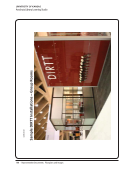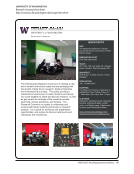46 · Survey Results: Survey Questions and Responses
Ability to combine services into one desk with partners from Student Success and IT.
Because of attrition in the libraries and the college of medicine, the opportunity to share the costs and services of the
remaining health sciences librarian arose. The impact has been an increased workload on the health science librarian,
but better and more efficient collaborations and resource sharing between the libraries and the college of medicine.
Creating the space and services offered new opportunity for collaboration with the business school.
Major collaboration with Information Services &Technology (IS&T) provided opportunity to reconfigure reference
service. IS&T’s interest in installing a new thin client based computer service that improved their software management
was an important factor in library renovation.
Subscription to 24/7 chat service.
The Education Library was already in the Education School, so it was assumed the collaboration would continue. The
facility is now managed by the school but staffed by the library, which leaves library staff more free to concentrate on
services rather than building maintenance, etc.
The library collaborated with the Graduate School of Library and Information Science on this change in service model.
The library partnered with Academic &Research Technology, a department within campus IT.
The opportunity for the libraries to collaborate with the university’s IT department, the provost’s office, and student
government helped make this a reality. The initial funding was shared among all groups and ongoing funding is shared
between the libraries and the IT department.
The provost’s investment in reshaping library spaces was critical to the success of the Research Commons project and to
all of our reconfigured service points. Partnership with university IT, Classroom Support Services, and Capital Resources
Planning was also key. They provided information and in-kind services to support our project and remain involved in the
evolution of the spaces.
We had already been participating in a group that provided us with access to the software used to provide digital
reference services. The software is configured in such a way that it allowed us to provide distributed service (service
from more than one location all at once) and was a factor in helping us move to the new service model.
We had the opportunity to expand on our collaborative relationship with the campus IT unit in the newly consolidated
Science Library. We had been very successful with opening a new service point with them in our main library in 2007.
We partnered with the campus IT service at a new Commons Desk so this did impact our decision to relocate the
Research Desk.
12. If an opportunity for outsourcing service delivery had a significant impact on the decision to
reconfigure this service, please briefly describe that opportunity and the impact it had. If this did
not have a significant impact, please enter NA for Not Applicable. N=52
48 responded NA.
Ability to combine services into one desk with partners from Student Success and IT.
Because of attrition in the libraries and the college of medicine, the opportunity to share the costs and services of the
remaining health sciences librarian arose. The impact has been an increased workload on the health science librarian,
but better and more efficient collaborations and resource sharing between the libraries and the college of medicine.
Creating the space and services offered new opportunity for collaboration with the business school.
Major collaboration with Information Services &Technology (IS&T) provided opportunity to reconfigure reference
service. IS&T’s interest in installing a new thin client based computer service that improved their software management
was an important factor in library renovation.
Subscription to 24/7 chat service.
The Education Library was already in the Education School, so it was assumed the collaboration would continue. The
facility is now managed by the school but staffed by the library, which leaves library staff more free to concentrate on
services rather than building maintenance, etc.
The library collaborated with the Graduate School of Library and Information Science on this change in service model.
The library partnered with Academic &Research Technology, a department within campus IT.
The opportunity for the libraries to collaborate with the university’s IT department, the provost’s office, and student
government helped make this a reality. The initial funding was shared among all groups and ongoing funding is shared
between the libraries and the IT department.
The provost’s investment in reshaping library spaces was critical to the success of the Research Commons project and to
all of our reconfigured service points. Partnership with university IT, Classroom Support Services, and Capital Resources
Planning was also key. They provided information and in-kind services to support our project and remain involved in the
evolution of the spaces.
We had already been participating in a group that provided us with access to the software used to provide digital
reference services. The software is configured in such a way that it allowed us to provide distributed service (service
from more than one location all at once) and was a factor in helping us move to the new service model.
We had the opportunity to expand on our collaborative relationship with the campus IT unit in the newly consolidated
Science Library. We had been very successful with opening a new service point with them in our main library in 2007.
We partnered with the campus IT service at a new Commons Desk so this did impact our decision to relocate the
Research Desk.
12. If an opportunity for outsourcing service delivery had a significant impact on the decision to
reconfigure this service, please briefly describe that opportunity and the impact it had. If this did
not have a significant impact, please enter NA for Not Applicable. N=52
48 responded NA.






















































































































































































































